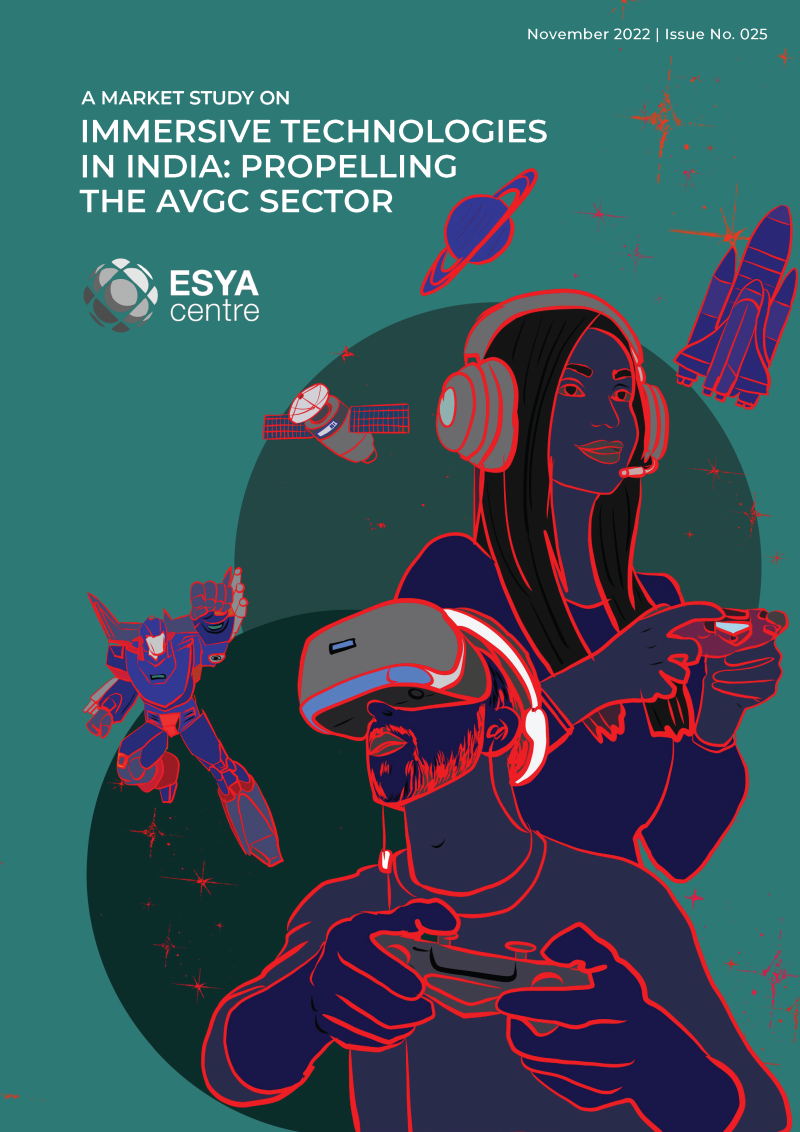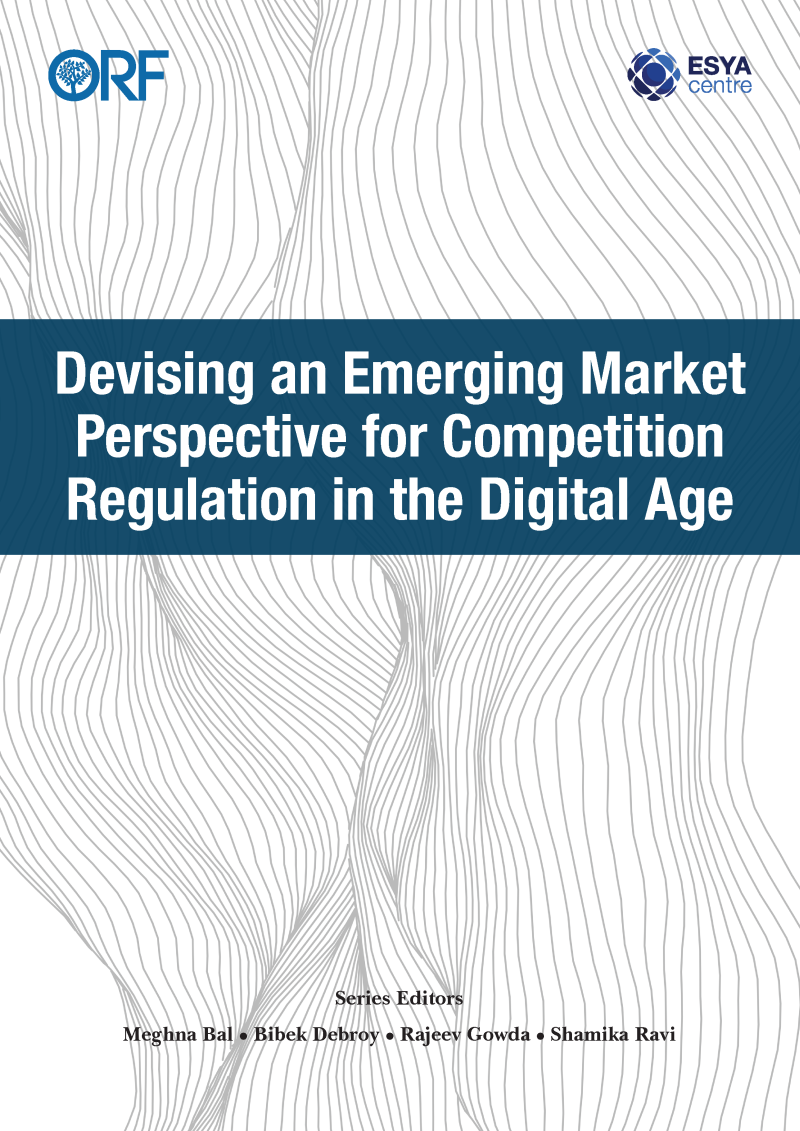The Competition Commission of India (CCI) opened public consultations on the Draft (Combinations) Regulations, 2023 (“Draft Regulations”) on September 05, 2023. The Esya Centre is pleased to be afforded an opportunity to respond to the draft regulations.
Response to the Public Consultation on the “Competition Commission of India (Commitment) Regulations and the Competition Commission Of India (Settlement) Regulations 2023"
Description: The Competition Commission of India (CCI) opened public consultations on two new draft regulations, namely the Competition Commission of India (Commitment) and the Competition Commission of India (Settlement) Regulations 2023 (hereinafter the Draft S&C Regulations), on August 28, 2023. The Esya Centre1 lauds the CCI for publicly consulting on draft versions of these two important regulations and is pleased to be afforded an opportunity to respond to both. Our response is divided into two parts. Part I provides a preliminary overview of our response, with Part II delving deeper into specific aspects of the regulations, such as timelines and confidentiality.
Attribution: Response to the Public Consultation on the “Competition Commission of India (Commitment) Regulations and the Competition Commission Of India (Settlement) Regulations 2023”. Issue No. 109, September 2023, Esya Centre.
G20 Digital Asset Regulation Tracker
G20 Digital Asset Regulation Tracker: To trace developments in the rapidly evolving field of digital asset regulation, the Esya Centre created the Digital Asset Regulation Tracker. The tracker provides an overview of the status of digital asset regulation in G20 nations. The idea is to create a ready reckoner for stakeholders interested in digital asset regulation in G20 countries.
Navigating Approaches to AI Governance: Charting a Pathway for India
Description: The clarion call for the regulation of artificial intelligence (AI) is growing louder across the world. Different jurisdictions have either introduced legislation to regulate the technology or are in the process of doing so. Aside from hard-coded laws, a bevy of voluntary standards have emerged around trust and safety concepts surrounding the deployment and development of AI. This paper presents a roundup of different approaches to AI regulation and governance, as well as the intersection of existing legal doctrines and AI. The purpose of this paper is to put forth considerations for Indian policymakers to take into account when deciding on AI governance down the road.
Attribution: Meghna Bal and Vivan Sharan. Navigating Approaches to AI Governance: Charting a Pathway for India. August 2023, Esya Centre.
Why India Needs an Intermediary Liability Framework for Web3 and What it Should Look Like
Description: The World Economic Forum defines Web3 as a growing segment of decentralised technologies that help “establish provenance, veracity, and value of data.” Web3 technologies, which include cryptography, distributed ledger systems, smart contracts and fungible and non-fungible digital assets, aim to redress the centralisation of data, with large Web2 internet companies, by returning ownership and control to users. This paper argues that the digital product aspect of Web3 should be regulated under a specialised intermediary liability framework targeting centralised Web3 or Web2.5 entities. Such a framework would ensure Web3 digital product risk redressal, while still enabling entrepreneurs to innovate.
Attribution: Meghna Bal and Mohit Chawdhry. Why India Needs an Intermediary Liability Framework for Web3 and What it Should Look Like. August 2023, Esya Centre.
New-Age Digital Consumption in India: A Survey of Social Media, OTT Content and Online Gaming
Description: This report examines the consumption and engagement patterns of users in India’s digital market. Three services from the digital consumption basket – social media, over the top (OTT) content services and online gaming – are in focus here. Each of these has witnessed sharp growth in its user base, revenues and innovation in recent years. The three services have also had a significant impact on users’ time-use for skill development, networking, and leisure/entertainment.
Attribution: Professor Rajat Sharma and Dr Vikash Gautam. New Age Digital Consumption in India: A Survey of Social Media, OTT Content and Online Gaming. July 2023, Esya Centre.
Unbundling the demand for a Network Usage Fee
Description: Major telecom service providers (telecom operators or telcos) in India are arguing for the introduction of a network usage fee for over-the-top (OTT) applications. They contend that there is currently a structural imbalance as OTT platforms allegedly benefit from telecom operator funded networks but do not invest in creating, operating, maintaining or expanding them. Relying on secondary research, this report evaluates the merits of their assertions. Broadly, the literature available indicates that contentions in favour of network usage fees may be incorrect.
Attribution: Noyanika Batta & Meghna Bal. Unbundling the demand for a Network Usage Fee. July 2023, Esya Centre.
Assigning Spectrum for Satellite Services in India
Description: The release of the Telecom Regulatory Authority of India’s consultation paper on “Assignment of Spectrum for Space-based Communication Services” in April 2023, triggered a debate on whether or not spectrum should be assigned across satcom services via auctions. It has also sparked concerns regarding access to sufficient satellite spectrum amongst global satellite operators such as Amazon (Project Kuiper) and OneWeb who want to enter the Indian market. The paper comes at a time when TRAI is consulting with stakeholders on spectrum assignment for space-based communication services. It presents a comprehensive analysis of technical, regulatory, and economic arguments on this issue and echoes the view of majority stakeholders.
Attribution: Tamanna Sharma and Niharika. Assigning Spectrum for Satellite Services in India. June 2023,Esya Centre.
Response to TRAI’s Consultation Paper on Regulating Converged Digital Technologies and Services- Enabling Convergence of Carriage of Broadcasting and Telecommunication Services
The Esya Centre is pleased to respond to the TRAI's Consultation Paper on Regulating Converged Digital Technologies and Services- Enabling Convergence of Carriage of Broadcasting and Telecommunication Services. We commend TRAI for providing an open platform for stakeholders to share their feedback on this critical issue.
Our response is divided into two parts. Part I presents our brief reactions to the consultation paper, while Part II provides a comprehensive analysis of our response. Our response is structured into five sections, each addressing a specific issue raised in the consultation. In each section, we examine TRAI's observations and propose counterarguments where necessary. Our aim is to engage with TRAI’s recommendations from first principles and bring attention to areas that may benefit from greater conceptual clarity.
Attribution: Response to TRAI’s Consultation Paper on Regulating Converged Digital Technologies and Services- Enabling Convergence of Carriage of Broadcasting and Telecommunication Services. Issue No. 107, April 2023, Esya Centre.
Information Warfare Through Social Media Platforms
Description: This paper focuses on information warfare operations conducted by foreign adversaries through social media platforms. Specifically, it considers challenges related to social media and information warfare in the Indian context and makes suggestions on how India may mitigate such threats, in particular by leveraging and partnering with domestic social media platforms. The recommendations in the paper emanate from global best practices in responding to these threats.
Attribution: Vaishnavi Prasad, Meghna Bal, Shweta Venkatesan, and Dr. Ajai Garg. Information Warfare Through Social Media Platforms. March 2023, Esya Centre.
Regulating Media Ownership in India: Challenges and the Way Ahead
Description: In April 2022, the Telecom Regulatory Authority of India (TRAI), the telecom and broadcast regulator, released a consultation paper (CP) on ‘Issues Relating to Media Ownership’. The Esya Centre and the Internet Freedom Foundation brought together media business owners, journalists, academics, and other stakeholders for a roundtable on media ownership in India. The stakeholders discussed various issues raised in the CP, including the links between plurality and ownership concentration, the adequacy of the existing legal framework, and difficulties in assessing ownership and control. This paper presents key takeaways from the discussion on the central aspects of the TRAI CP. It also suggests recommendations for policymakers on how the regulation of ownership in media markets can be improved.
Attribution: Mohit Chawdhry. Regulating Media Ownership in India: Challenges and the Way Ahead. March 2023, Esya Centre.
Addressing Regulatory Fragmentation in Cross-Border Data Flows
Description: The rules governing cross-border data flows are becoming increasingly fragmented, at the domestic and international level. In April 2020, some 128 of 194 countries had data protection rules in place. While these laws manifest different approaches to cross-border data transfers, trends suggest that restrictions are growing on free data flows. This paper examines the competing approaches to cross-border data flows and identifies some challenges. It also explores India’s new approach to cross-border data flows, and the opportunity the country can seize to champion a more harmonised regulatory approach.
Attribution: Vaishnavi Prasad. Addressing Regulatory Fragmentation in Cross-Border Data Flows. February 2023, Esya Centre.
Code of Conduct Template for Self-Regulatory Bodies in Online Gaming
Description: The Ministry of Electronics and Information Technology (‘MeitY’) released proposed amendments to the Information Technology (Intermediary Guidelines and Digital Media Ethics Code) Rules, 2021 (“Rules”) on 2nd January 2023. The draft amendments bring online games and online gaming intermediaries within the scope of the 2021 Rules. The draft amendments establish a self-regulatory framework for online gaming. The adoption of a self-regulatory framework for online gaming reflects an emerging consensus on the suitability of industry self-regulation for digital technologies.
Self-regulation is preferred in digital industries as it tends to be more agile and responsive to technological change than government regulation. In response we put together a template code of conduct to provide a framework that self-regulatory bodies can adopt to govern their functioning.
Attribution: Code of Conduct Template for Self-Regulatory Bodies in Online Gaming. Issue No. 106, February 2023, Esya Centre.
Impact of VDA Tax Architecture on Risk Exposure of Indian Investors
In a recently published Esya Centre report “Virtual Digital Asset Tax Architecture in India: A Critical Examination”, we show that the main (unintended) impact of the tax policy on Indian VDA industry is offshoring of domestic business and liquidity to foreign exchanges. This report, extends the earlier work by examining – how the tax architecture changed the risk exposure of investors trading on centralised VDA exchanges in the country.
Regulation of OTT Communications Services: Justified Concern or Exaggerated Fear?
Description: Telecom service providers (TSPs) have been pushing for the regulation of over-the-top (OTT) service providers in India since 2015. Meanwhile, OTT firms maintain that their services are not comparable with telecom. The debate centres on two issues in particular: same service, same rules and infrastructure cost sharing. The merits of the TSPs’ demands and counterarguments are explored in this paper.
Part 1 of this paper outlines the demands raised by TSPs and the merits of these from a historical and legal perspective.
Part 2 of the paper compares OTT regulation trends across some jurisdictions. The aim is to trace the changes made to telecom regulations internationally in response to emerging technologies and ask whether OTTs have been brought under the regulatory regime for TSPs.
Finally, in Part 3 of the paper, through insights from historical and legal analysis and from a comparative standpoint, we recommend the approach the government should adopt.
Attribution: Noyanika Batta. Regulation of OTT Communications Services: Justified Concern or Exaggerated Fear? January 2023, Esya Centre.
Virtual Digital Asset Tax Architecture in India: A Critical Examination
Description: This report is the first empirical exercise to estimate the impact of India’s tax policy on centralised Virtual Digital Asset (VDA) exchanges, that are similar to stock exchanges for digital assets. It examines the impact of three events on the centralised virtual digital asset (VDA) industry in India, announced on 1st February 2022 during the Union Budget 2022-23: (a) a levy of a flat 30 percent tax on gains from VDA trade applicable from 1st April 2022; (b) a levy of 1 percent tax deducted at source (TDS) on transactions above INR 10,000 from 1st July 2022; and (c) the provision disallowing the offsetting of losses applicable from 1st April 2022s.
Attribution: Dr. Vikash Gautam. Virtual Digital Asset Tax Architecture in India: A Critical Examination. Special Issue No. 208, January 2023, Esya Centre.
Price Discovery in the NFT Market
Description: This paper examines the price discovery mechanism of non-fungible tokens, or NFTs. That is, how do the forces of supply and demand determine an NFT transaction? We use data on some 55,000 unique NFTs with 16,000 creators/artists, and 15,000 collectors/buyers on Foundation, one of the largest NFT exchange platforms, to address this question.
Attribution: Dr Vikash Gautam and Tamanna Sharma. Price Discovery in the NFT Market. December 2022, Esya Centre.
Quantification of Intangible Cultural Assets
Description: A study on Quantifying the Contribution of Intangible Cultural Assets (ICAs) to the Economy of Rajasthan, under the aegis of the Chief Minister’s Rajasthan Economic Transformation Advisory Council (CMRETAC). It lists out a comprehensive set of policy recommendations for protecting, preserving, and promoting ICAs in the state. This is a pioneering study in the country, owing to its state-wide coverage.
Attribution: Quantification of Intangible Cultural Assets. December 2022, Chief Minister Rajasthan Economic Transformation Advisory Council (CMRETAC), Department of Planning Rajasthan, and Esya Centre.
Market Study on Immersive Technologies in India: Propelling The AVGC Sector
Description: This report explores how immersive technologies will change the way creators produce content and audiences consume it.. The report also assesses the readiness and competitiveness of India’s AR/VR industry and suggests some policy measures that could further bolster the sector based on insights from semi-structured interviews with relevant stakeholders in the AR/VR ecosystem.
Attribution: Vani Tripathi Tikoo, Akshat Agrawal, Varun Kakar, Mohit Chawdhry and Vaishnavi Prasad. Market Study on Immersive Technologies in India: Propelling the AVGC Sector. November 2022, Esya Centre.
Devising an Emerging Market Perspective for Competition Regulation in the Digital Age
Description: This report is first in a series on Indian Perspectives on Competition Regulation in Digital Markets co-published by the Observer Research Foundation (ORF) and the Esya Centre. It is a synthesis of insights that were shared during a discussion, convened by the Esya Centre and ORF, among stakeholders belonging to the public sector, industry, academia, and consumer interest organisations as a first step towards formulating a position on digital competition regulation for India.
Attribution: Meghna Bal, et al., Eds., Devising an Emerging Market Perspective for Competition Regulation in the Digital Age, November 2022, Observer Research Foundation and Esya Centre.



















